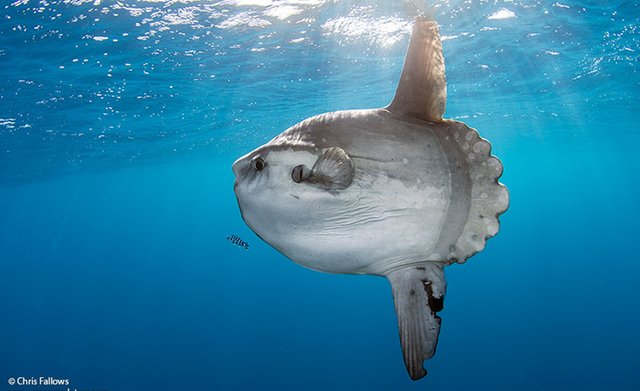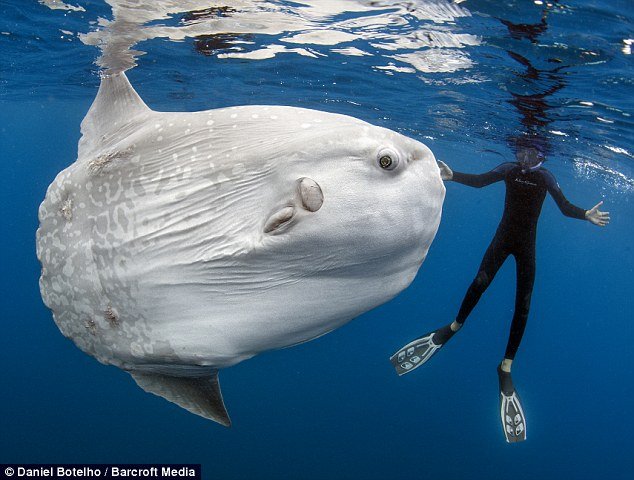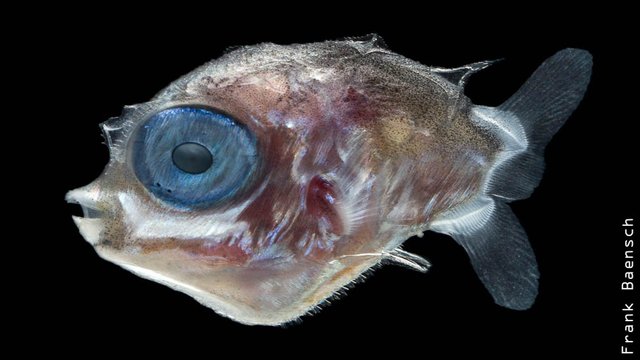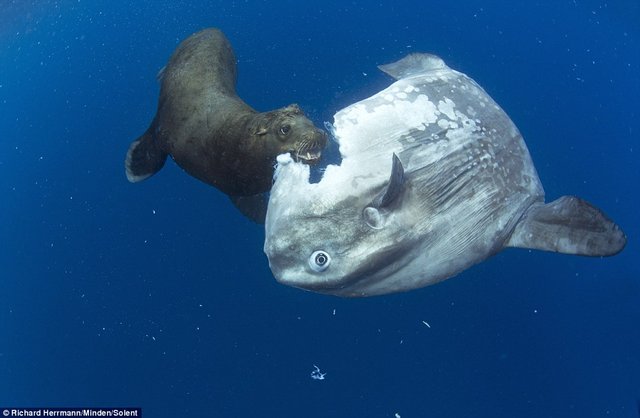Amazing Animals #24 The Ocean Sunfish
It’s safe to say that cute and fluffy animals reign supreme when it comes to exposure to the general population, but weird and wonderful creatures also worm themselves in to the limelight occasionally, sometimes by virtue of strange adaptations, but more often than not due to a strange ugliness that almost makes them appear cute.
I personally find the strange biological anomalies of this world incredibly interesting to study, and the fish I’ve chosen today is quite the creature, it looks as though it was created by someone using photoshop and doesn’t really look like it should be able to swim.
The adaptations they have evolved over millions of years makes it appear alien to the fish that surround it, with some of them being completely unique to its family group, it’s quite often the case that the strangest of creatures have evolved in our Oceans, the Sunfish is one of those creatures worth talking about.
Description and Anatomy
The Ocean Sunfish (Mola mola) is the sixth largest fish in the Ocean based on maximum estimated weight, the five species larger than the Ocean Sunfish are all cartilaginous Sharks which makes the Sunfish the largest bony fish in the Ocean, from this point on we’ll refer to this animal simply as the “Sunfish”.
When matured they are so large that even average specimens are considerably larger than most other bony fish in the Ocean, an average sized Sunfish weighs between 300 and 1000 kg’s, larger than average specimens can easily surpass 1000 kg’s and they are thought to be able to reach a body mass of up to 2300 kg’s, an animal this size would weigh more than a pickup truck
From a morphological viewpoint they are definitely one of the strangest creatures in the Ocean, despite their large size they almost appear incomplete, they can grow to lengths of up to 3.3 metres though average individuals are normally closer to 1.9 metres.
Strangely they are one of the few animals in the ocean that can be as tall as they are long, one of the standout features of the Sunfish is the presence of a very large dorsal and anal fin that appear mirrored to each other, from the tip of the dorsal fin to the tip of the anal fin the average length is 2.5 metres though they are thought to have a maximum size of a mind-boggling 4.2 metres, only marginally shorter than a double-decker Bus!
Another strange feature of the Sunfish is the complete absence of a caudal fin, this is an incredibly rare trait for a bony-fish and to my knowledge is unique to members of the Molidae family, the caudal fin has evolved in to a convergence between the anal and dorsal fin known as a clavus, the clavus does not function as a caudal fin however, instead it remains fixed and the Sunfish propels itself through the water by moving its dorsal and anal fin in a manner not to dissimilar from how oars are used to propel a rowboat.
By observing the skeleton of the Sunfish, we can clearly see that it evolved from a species that originally had a functioning caudal fin, as the species has evolved they have retained 12 fin rays which would otherwise not be present, throughout their evolution these fin rays have become progressively separated and they now give the Sunfish a humped appearance which can be quite dramatic in larger individuals.
Compared to their body size they have very small fan-shaped pectoral fins, these fins are thought to help the Sunfish remain stable in a vertical position, they are located just behind the Operculum, which is a single gill opening that allows water to be expelled from the body, the Sunfish is able to use its pectoral fins in unison with rapid water expulsion to orient itself in the water.
As members of the Tetraodontiformes order of fish they are related to Pufferfish, Triggerfish and Filefish and they share certain characteristics, the most common being they are slow moving, this is because they are Ostraciiforms which means they have a rigid body and are incapable of lateral flexure that would normally permit acceleration via body undulations, Ostraciiforms rely on the use of their fins for propulsion.
As slow-moving animals this leaves them open to predation, luckily for the Sunfish their skin is very tough and leathery which only leaves them vulnerable to large species of Shark and Toothed Whales, it has been speculated that the organs of Sunfish also contain low levels of Tetrodotoxin, the neurotoxin famed for the special preparation required to enable safe eating of certain species of Pufferfish is thought to be present within the Intestines, Liver and ovaries of the Sunfish.
Aside from the lack of a Caudal fin the Sunfish has a couple of other characteristics that are Alien even to other species within the order Tetraodontiformes, namely their skin is completely devoid of any plates, scales or spines and they also lack a gas filled swim bladder to control their buoyancy, a 2008 journal article states:
‘It was demonstrated that despite the missing swim-bladder, ocean sunfish are neutrally buoyant (mean body density 1,027 ± 4 kg/m3, N = 20) in seawater (density ca. 1,026 kg/m3) and that a thick layer of low-density, subcutaneous, gelatinous tissue plays a major role providing this buoyancy (Watanabe and Sato 2008).’
This gelatinous tissue is incompressible and allows the Sunfish to dive rapidly without experiencing changes in buoyancy that would otherwise be experienced by fish with a traditional swim bladder, the tissue is thought to account for up to 44% of their overall body mass and may be able to support between 69 and 100% of its body weight in the water, support is also theorised to exist from their endoskeleton which contains large deposits of cartilaginous tissue as well as bone, this is another strange trait unique to the Sunfish and is thought to be the key reason behind their gargantuan growth which is seldom seen in bony fish.
They have arguably the smallest mouth size to body ratio of any large animal (I say large as Dragonets, Scooter Blennies and Pipefish all have similarly small mouths), their mouth does contain teeth however they are fused to create a beak-like structure, furthermore they have Pharyngeal teeth within their throat which will be explained when exploring their diet.
Their tough leathery skin is almost always grey / white in colouration and individual specimens can display a wide array of speckled / mottled patterns, their skin can be up to 3 inches thick in certain areas, instead of the commonly observed scales of Tetraodontiformes they have a multitude of denticles across their body and their entire skin is coated in a layer of mucus.
Lastly, they have the fewest number of vertebrae of any fish at just 16, this also leads to them having the shortest vertebral column in relation to their body size of any animal in the Ocean, other than their lack of a swim bladder they also do not possess a standard set of Rib bones or pelvic fins.
Diet and Behaviour
The Sunfish is by all accounts a slow-moving animal, thought to be capable of achieving top speeds of only 2 miles per hour, therefore their prey can only really consist of organisms that are either slower than the Sunfish, or organisms that lack the eyesight or spatial senses to detect an incoming giant.
Like our previously covered animal the Leatherback Sea Turtle the diet of the Sunfish consists mainly of Jellyfish which makes up between 15 and 40% of their diet, the rest of their diet consists of Crustaceans, Cephalopods, Fish, Crinoids and large quantities of various Algae, generally speaking their prey are quite small in size which means the Sunfish must eat frequently, like most fish they will simply gorge throughout the day.
They do not predate specifically on a single species of Jellyfish and appear to eat anything presented to them so long as it appears edible, despite not being fussy over what’s on the menu they do display quite methodical behaviour when consuming Jellyfish, instead of biting down on the Jellies they opt to suck and expel the animal rapidly, this breaks the Jellyfish down into gelatinous chunks that can be more easily consumed, they frequently leave the lobe of the Jellyfish behind prioritising feeding on the nutritious tentacles and reproductive organs, the Sunfish is thought to be immune to the Jellies nematocysts as their throat is lined with a relatively thick mucus layer for protection, furthermore their pharyngeal teeth prevent prey from escaping and aid in the shredding of soft-bodied organisms.
As their diet is quite extensive this signifies that the Sunfish must feed at various different levels of the water column, they are pelagic fish that live between 0-800 metre depths in the open ocean, their previously mentioned biology allows them to dive and surface quite rapidly compared to other fish thus avoiding the common issues associated with decompression.
Strangely, since their discovery many people considered the Sunfish to be the largest Planktonic creature in the Ocean, a Planktonic organism is simply defined as an organism that floats and drifts along with Ocean currents, after analysing the behaviour of the Sunfish this is easy to observe why some people would have believed this.
Most visible sightings of Sunfish occur near the surface (<10 metre depths), this isn’t a strange phenomenon, replace the word Sunfish with the word Shark and you get the same majority sightings, the difference between the two is their manner of movement, Sunfish can almost appear to be dead when floating near the surface with little to no fin movement as they bob along with the Oceanic swells.
This behaviour has since been proven to serve a multitude of benefits for the Sunfish, firstly, to accommodate their discovered deep sea diet they must overcome a common issue of a cold blooded animal, at depths of below 200 metres the temperature can drop rapidly and can even drop to near freezing at depths of 800 metres, therefore the Sunfish will need to warm-up sufficiently prior to embarking on a hunt to the depths, by sunbathing at the surface the Sunfish is able to warm itself effectively whilst also expending very little energy.
Another benefit to their docile sunbathing behaviour arises in the form of parasite control, as they are large slow-moving creatures they attract a multitude of parasites, the most frequent being the Flatworm species Accacoelium contortum, these parasites can have a largely detrimental effect on the Sunfish and can cause some serious problems (respiratory failure in extreme cases) if left unchecked, as the Sunfish floats peacefully with the current several species of small fish such as Wrasse peck at parasites on the skin of the Sunfish which helps to control parasite populations, on rare occasions the Sunfish has even been observed to breach the waters surface to allow Seabirds to also feed on visible parasites.
Sunfish are not considered to be social creatures and the vast majority of sightings will consist of a single individual, on rare occasions they can be observed travelling as a pair or in groups, this may offer an insight in to their reproduction, despite being so large and easy to spot, very little is known regarding their mating behaviours aside from the fact that the male fertilises the eggs externally and neither fish take care of the offspring, specimens that have been sighted together and tagged have not subsequently remained together.
Reproduction
They appear to be opportunistic breeders and males are thought to simply take advantage of a fertile female should they happen to come across one in the vast Oceanic expanse, once located the female will proceed to release her eggs, female Sunfish produce the most eggs in a single cycle when compared to all known vertebrates on the planet, during copulation she will release up to 300 million eggs which the male will then fertilise externally.
The fertilised eggs are free floating and measure roughly 0.13cm which makes them a highly nutritious feeding opportunity for small predators, after fertilisation they grow in size rapidly after hatching and will go through two distinct larval stages.
During the first stage their body is rounded and has protruding spines that extend outwards from the edges of their body, they also have a fully functional and normal sized tail and caudal fin, upon observation they more closely resemble Pufferfish, upon hatching they measure roughly 0.25cm in length and weigh only fractions of a gram, they will feed on planktonic matter until they have grown sufficiently at which point they become “fry”.
Once the second Larval stage begins they undergo a series of dramatic morphological changes, their protruding spikes disappear, their dorsal and anal fins begin to elongate, and their tail and caudal fin gradually disappear completely to form the Clavus, at this stage the Sunfish will school with other juveniles for protection and will gain weight at a rate up to 0.82 kg’s per day, once they have reached a decent size they will embark on their solitary journey where they will continue to grow at an incredible rate, by the time they are fully grown they may have increased their weight by 60 million times the amount of their birth weight, this is the largest known increase in weight of any known vertebrate.
Their range is thought to extend across all temperate and tropical Oceans around the globe and they have been observed to cover distances of up to 26 kilometres a day when moving between feeding grounds, this further dispels the myth that they rely heavily on Ocean swells for mobility, sadly their population is currently on a downward trend with gill nets posing the largest manmade threat to them, the gill nets themselves do not kill the fish but a tangled Sunfish will eventually die of exhaustion if left for long periods of time, if you want an example of true depravity some fishermen cut the fins off of Sunfish as they are considered worthless and “bait thieves”, the Sunfish will eventually die with no means of propelling itself.
Sunfish? Swimming Head? Finned Dinner Plate?
As to be expected with any creature that is both large and odd looking, the first thing that comes to mind is, what do we call it? The second thing that comes to mind is, can we keep it?
Both of these questions have been answered and since the first documented encounter with a Sunfish in 1758 it has gathered a multitude of differing names across several languages.
The name we have used throughout this article, the “Sunfish”, is the commonly used English name given to the animal for its tendency to bask in the glory of the sunshine at the waters surface, conversely it is also known as the Moonfish in a multitude of different languages which choose to focus more on the rounded shape of the animal.
Others have named the fish for its strange appearance that resembles a floating head, in German the fish is alternatively named Schwimmender Kopf which translates as “swimming head” (it’s also what I’m going to call it from now on, in German of course).
Its scientific name derives from the Latin word “Mola” which translates as millstone, their rounded grey shape and rough textured skin leads this to be a fitting name for the animal which leads to it’s other widely used name, the common Mola.
To answer the second proposed question I feel an article on the captivity of large Marine creatures would likely be required and this may be an interesting topic in itself to discuss as the sheer scale and parameters of their enclosures are incredibly vast and complex.
Amazing Facts
Their large eyes give them surprisingly good vision, as a predatory fish they rely heavily on their eyesight to spot prey, their eyes continue to grow as they age and their vision is thought to improve the larger they grow.
Whilst their maximum cruise speeds of 2 Mph aren’t impressive, they can achieve short bursts of speed that even allows them to completely breach the water, this behaviour is most commonly speculated as the fishes attempt to remove external parasites from its skin.
Despite their daunting size they are largely harmless to Humans, they often display inquisitive behaviour towards us and divers have regularly cited that the fish have approached them without the need for bait, the only classified instance of an injury from a species of Sunfish occurred when an individual breached the water and landed on a small boy on a Boat.
The only known predators of mature Sunfish are Great White Sharks, Orca and Californian Sea Lions, the remains of a 1.8-metre-long Sunfish were found inside a Great White Shark caught off the southern coast of Italy.
They are incredibly numerous in some regions, it was reported in one year alone a South African fishery caught approximately 340,000 individuals in a single year as a result of by-catch, their incredibly fast growth rate and large spawns has likely kept the Sunfish populations from reaching critically low levels in recent years.
In warmer waters they spend up to 80% of their time at depths of 0-200 metres, this was discovered in a study of 31 tagged specimens over the course of 240 days, deep dives mainly occurred in specimens located within the Gulf stream.
Content Sources
More Amazing Animals
If you Enjoyed this article feel free to check out some of my previous editions of Amazing animals.
- The Leatherback Sea Turtle
- The Fruit Bats
- The African Elephant
- The African Lion
- The Arctic Fox
- The Peregrine Falcon
- The Komodo Dragon
- The Great White Shark












In the 1970s, about a mile off of Gulf Shores, Alabama, in the Gulf of Mexico, on a day when the Gulf was the clearest I ever saw it, my late father and I in our boat that he built saw a sunfish perhaps 15 feet down, with a headlike body about 2 feet tall, much taller if you counted the fins. It was "attended" by a dozen or so brown fish, maybe 8 or 9 inches long, that kept nipping at it, presumably eating parasites. We saw the sunfish bite a large flat jellyfish, of a type we never saw before or since, not quite a yard wide, clear with brown and black markings. The sunfish placidly spat out the bite it had taken and slowly turned away from the jellyfish, which also appeared unperturbed by the affair.
The clarity of the water would have made my estimates of sizes and proportions pretty suspect.
Feels like I just watched national geographic.
@amavi a very nice write up on this fish! I remember seeing this fish for the first time at the Monterey Bay Aquarium. A really spectacular fish to see in real life.
Cheers!
ian
I desperately want to visit the Monterey Bay aquarium, maybe one day, everything about it just looks amazing.
Does this exist for real? This fish looks like a missile (the one in Mario Bross) :D
The molamola, what a great animal. We saw one during our dive at Nusa penida, Indonesia. It was about 32 meters deep and there was a strong current. We were so lucky. We dived many times overthere, but we only see one.
Nice post to learn more about this amazing fish.
Wow, I have never seen the baby sunfish!!! It's cute.
And I must admit I never understood the physics of this fish. Hydro/Aerodynamics is something completely non-intuitive to me
Okay I've seen these before and, yeah, they're cool. But i've never seen a skeleton. Kind of creepy, not sure I'm still a fan :/
They are definately strange looking creatures, evolution produces some wonderful oddities!
Holy carp they're kinda big O_O I recognise the thing from the shape as I've seen photos of it before but never one with humans for some reason so didn't realise how massive they were XD
Resteemed to over 13400 followers and 100% upvoted. Thank you for using my service!
Send 0.200 Steem or 0.200 Steem Dollar and the URL in the memo to use the bot.
Read here how the bot from Berlin works.
We are happy to be part of the APPICS bounty program. APPICS is a new social community based on Steem. The presale was sold in 26 minutes. The ICO will start soon. Read here more: https://steemit.com/steemit/@resteem.bot/what-is-appics
@resteem.bot
Wht is this man!😱😱